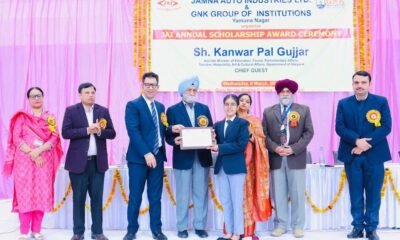Bank holds 82nd AGM of shareholders
BK News
Srinagar, Sept 28: J&K Bank held the 82nd Annual General Meeting (AGM) of its shareholders for the financial year 2019-20 through videoconferencing from its corporate headquarters in view of the ongoing Covid-19 pandemic.
Financial Commissioner Arun Kumar Mehta represented the J&K UT Government, the majority shareholder of the bank. Besides, the bank’s Chairman and Managing Director (CMD) RK Chhibber, Directors on board of the bank, Executive Presidents, Presidents, Vice Presidents, Company Secretary and a large number of its shareholders attended the e-AGM through virtual mode.
Summing up the bank’s performance during the FY 2019-20, the CMD stated, “Despite the COVID-19 crisis which had far-reaching economic and social repercussions, J&K Bank has delivered a strong balance sheet. During the fiscal, the Bank registered an Operating profit of Rs 1525.05 crore, with an improved NIM of 3.92%. Further, taking cognizance of the continued pressure on asset quality due to impact of COVID-19, the bank enhanced NPA Coverage ratio by more than 14 percentage points from 64.30% to 78.59% while bringing down the net NPAs considerably from 4.89% to 3.48%”
“Cost of deposits was maintained at 5% by improving the CASA base to 53.66%. The loan-book of UTs of J&K and Ladakh have witnessed the growth of 13% thereby re-orienting the lending composition of the bank with UTs of J&K and Ladakh getting 63% of total advances of the Bank”, he added.
Citing increased provisions as a reason for hiccups in the Bank’s journey towards glory during the last many quarters, the CMD attributed it to the increase in the level of NPAs due to impairments in the corporate portfolio outside J&K, primarily contracted under consortium/multiple bank arrangements.
“Now that J&K Bank has shifted its focus to retail and agriculture lending across the country and corporate lending has been restricted to top-rated corporates, the shift has begun yielding favourable results”, the CMD said.
Expounding on the effects of dual challenges faced by the bank since the second quarter of the FY 2019-20, Chairman R K Chhibber said, “Shortly after the disturbances during the second quarter of FY 2019-20 derailed the trade activities, the bank had to face an unprecedented disruption in the economic activity, caused globally by the COVID19, which has led to major changes in operations of trade, commerce and industries without exception.”
“The Bank was the first-mover in various initiatives which include introducing a top-up finance scheme for the business community to ease their cash flow issues, making hassle-free overdraft available in PMJDY accounts, the generous contribution of 3 days’ salary by all staff members to the COVID relief fund, disbursement of social security benefits to female PMJDY account holders, PM KISAN beneficiaries”, he added.
“J&K Bank was also quick”, he asserted, “to pass on benefits of a moratorium on loan instalments & interest servicing, announced as relief package by the Central Government, as per regulatory guidelines’, adding, “We also extended the COVID-19 stimulus package under Guaranteed Emergency Credit Line (GECL) to eligible businesses & MSMEs. Under the Central Government’s Guaranteed Emergency Credit Line (GECL) scheme, the Bank has so far made disbursements to the tune of Rs 1639.70 crore to 46516 borrowers.”
Terming the announcement of Rs 1350 Cr financial package by the LG of J&K UT as a game-changer, he further stated, “It will help not only in revival of businesses in the UT of J&K but also relieve the Bank from a major portion of stressed assets resulted out of the current situation. Interest subvention of 5% announced in the financial package by LG J&K Manoj Sinha along with the release of previous year’s interest subvention aggregating to about Rs 1081 crore in favour of business community shall help in the regularization of stressed assets and improving the overall asset quality of the bank.”
Sounding optimism for the future in the near term, the CMD stated, “We don’t foresee any major slippages during the current fiscal. Besides, the special provisions of around Rs 300 crore made in terms of RBI’s COVID19 regulatory guidelines expected to be released soon shall further improve the profitability in the current FY. The efforts made by the bank have started reaping benefits as is evident from the bank’s profitability, though modest, achieved in the first Q1 FY2020-21.”
Regarding the process of capital augmentation, the CMD said that the Bank is in the process of augmenting its capital base by raising additional Rs 4500 Crore, which would support the bank’s growth over the next few years besides meeting regulatory capital requirements.
Speaking about few of the decisions with far-reaching consequences for the bank, Chairman asserted, “Implementation of RTI Act and CVC guidelines has been a major step taken by your Bank aiming at further strengthening the corporate governance and accountability framework of your bank thereby enhancing transparency and efficiency as the flagship company in the UTs of J&K and Ladakh. These measures have helped in streamlining the processes and making this institution stronger and healthier going forward.”
Extending gratitude to all the stakeholders i.e. UT Government, shareholders, bank staff and customers, the CMD said, “On behalf of my colleagues on the Board of Directors, I would like to thank each member of the J&K Bank family for their hard work and commitment. I thank our promoters, the Government of UT of J&K for lending their unflinching support. Thanks to our valued customers, the Government of UT of Ladakh and shareholders for the continuing faith in J&K Bank”, adding, “We look forward to continuing this journey with you to take J&K Bank to greater heights.”
Earlier, the Company Secretary Mohammad Shafi read out the Auditor’s Report, comments from Comptroller and Auditor General (C&AG) besides providing background for business items to be transacted at the AGM.
Towards the end of the meeting, a question-answer session was held, wherein the CMD responded to different queries to the satisfaction of the shareholders. At the end of the meeting, the CMD expressed his heartfelt gratitude to all the e-participants in the AGM for their active participation. Meanwhile, the results of e-voting along with the scrutinizers report shall be available on the website of the bank and communicated to stock exchanges and KFin Technologies within 48 hours of the conclusion of AGM.



 Industry4 years ago
Industry4 years ago


 Economy2 years ago
Economy2 years ago


 Energy4 years ago
Energy4 years ago


 Infra4 years ago
Infra4 years ago


 AgriBiz4 years ago
AgriBiz4 years ago


 Careers4 years ago
Careers4 years ago


 Jobs4 years ago
Jobs4 years ago


 Economy4 years ago
Economy4 years ago





















